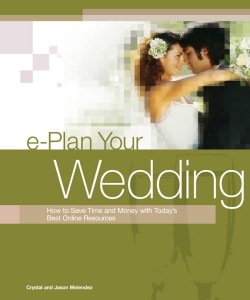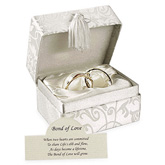 By: Crystal and Jason Melendez
By: Crystal and Jason Melendez
In Your wedding ceremony is an outward expression of the love you have for each other, and enables those closest to you to witness and be involved in one of the most special moments in your lives.
The key elements to just about any Western wedding ceremony are pretty much the same, whether the ceremony is religious or not. Certainly religion will add its own traditions and rituals, but the basic elements will still be present. Likewise, if you’re having a civil ceremony, you and your officiant will simply plan on a variation of these components (unless you’re cutting to the chase and tying the no fuss county courthouse appearance). Civil officiants typically provide a basic structure to which you can then add your own preferential details. The extent to which you tailor the basic elements with your own personal touch will make your wedding ceremony truly yours.
Procession
The entrance of the groom, parents, bridal party and the bride is symbolic of the marriage itself: You each enter separately, representing your individual lives leading up to the point where you both meet. In your wedding procession, you meet at the altar or stage, flanked by those closest to you and backed by your family for support, as you merge your lives into one.
During religious ceremonies, the procession of you, your sweetheart, your parents, and your bridal party typically has a prescribed format, although you can certainly add your own touches. For civil ceremonies it’s all up to you. You might very well decide to follow one of the familiar religious processions or at least base yours on one.
In a traditional Christian procession, the groom, his best man, and the officiant stand at the altar facing the doors of the church. The groomsmen can either enter together before the procession and stand up at the altar with the groom, or they can enter down the aisle in the procession, each accompanying one of the bridesmaids. The bridesmaids come down the aisle starting with the one who will stand farthest from the bride, followed by the maid or matron of honor, the ring-bearer and flower girl, and finally the bride. The bride walks to the left of her escort, who is traditionally her father (you may choose to be escorted by whoever you wish, however, or even to take the trip solo). Relatives are seated in the front rows of the church, with the bride’s family and friends on the left and those of the groom on the right.
A traditional Jewish procession begins with either the Rabbi or cantor (or both), followed by the groom’s grandparents, and then by the bride’s grandparents. The groomsmen proceed afterwards in pairs, followed by the best man, then the groom with his father to his left and mother to his right. The bridesmaids proceed starting with the one who will stand farthest from the bride and ending with the maid or matron of honor. The ring-bearer and flower girl are next. The bride proceeds to the altar last, traditionally escorted by both of her parents: her father to her left and mother to her right. Family is seated at the front, and the bride’s friends and relatives sit on the right, with those of the groom on the left.
Opening
The officiant will begin by announcing the couple and their intent to marry, and by welcoming the guests to participate as witnesses, supporters, and (if the ceremony is a religious one) with their prayers. During the opening, the official will also remind everyone of the importance and solemnity of the ceremony that is about to take place.
Main Body
The nature and meaning of marriage will usually be addressed here by the officiant, including its significance in light of God and the church if the ceremony is a religious one. The importance of the bride and groom’s decision to become man and wife is laid out in this context. The officiant will also often include more casual comments on how he or she has gotten to know the couple, their fitness for one another, or even an entertaining story or two, especially if the couple has known the officiant for some time.
At this time, religious or other readings may be given by the officiant and any other individuals who the couple might have asked. For non-religious ceremonies, poems or other text with special meaning to the couple are often read.
Vows
Both the bride and groom face each other, hands held, and individually assert their intentions to marry and their commitment to the other. Some couples choose to use the familiar, time-worn vows that have been repeated by countless couples before them. Many feel that this timeless aspect to traditional vows often lends a greater weight to the words, underscoring their importance. Other couples opt instead to personalize their ceremony even more by writing and reciting their own vows, emphasizing the uniqueness of their relationship and expressing what their future together means for them. If you and your sweetheart decide to write your own vows, you’ll usually need to run them by your officiant ahead of time,
After the exchange of their vows, the bride and groom are officially married in the Western Christian tradition.
At the direction of the officiant, the bride and groom each places a ring onto the finger of their betrothed, with an explanation of the action’s significance and promise of commitment. The rings, an ancient tradition dating back for centuries, symbolize unity and an everlasting bond.
After the exchange of rings, the bride and groom are officially married in the Western Jewish tradition.
Unity Rituals
While the exchange of wedding rings is one of the most familiar unity rituals to us, many religions or cultures include others, and some couples—whether the ceremony is religious or not—add their own. The unity candle is a popular choice, for example.
Pronouncement of Union
The officiant will announce that the couple is officially wed, and will introduce the newlyweds to the guests. The officiant will also often let the new husband know that he can ‘kiss the bride” at this point.
Closing Remarks
This is the official wrap-up of the wedding ceremony, and the officiant will end with some closing words and a final prayer or blessing if the ceremony is a religious one.
Recession
After the ceremony, the bride, groom, bridal party, and family leave the ceremony location in essentially the reverse order of the procession, except that the bride and groom leave first (hand in hand!) and everyone else follows in turn.
————————————-
ABOUT THE AUTHORS:
Crystal and Jason Melendez are the authors of e-Plan Your Wedding:
How to Save Time and Money with Today’s Best Online Resources
For more information, please visit http://www.eplanyourwedding.com


